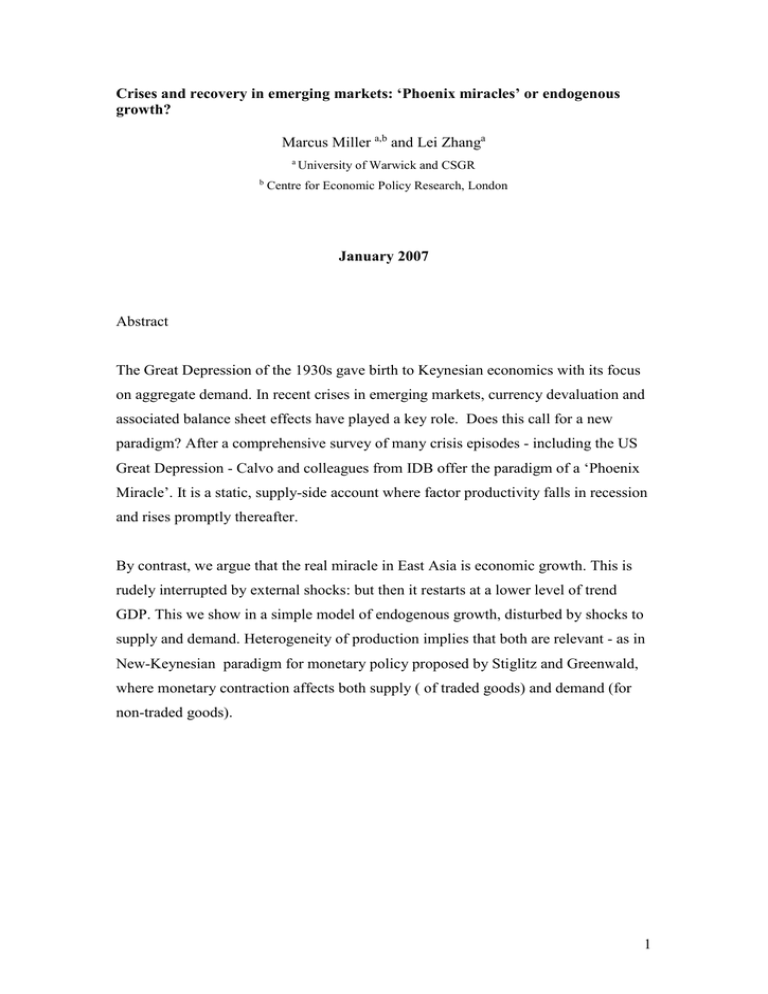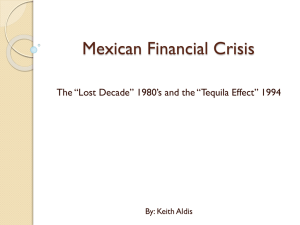Marcus Miller and Lei Zhang Abstract
advertisement

Crises and recovery in emerging markets: ‘Phoenix miracles’ or endogenous growth? Marcus Miller a,b and Lei Zhanga a b University of Warwick and CSGR Centre for Economic Policy Research, London January 2007 Abstract The Great Depression of the 1930s gave birth to Keynesian economics with its focus on aggregate demand. In recent crises in emerging markets, currency devaluation and associated balance sheet effects have played a key role. Does this call for a new paradigm? After a comprehensive survey of many crisis episodes - including the US Great Depression - Calvo and colleagues from IDB offer the paradigm of a ‘Phoenix Miracle’. It is a static, supply-side account where factor productivity falls in recession and rises promptly thereafter. By contrast, we argue that the real miracle in East Asia is economic growth. This is rudely interrupted by external shocks: but then it restarts at a lower level of trend GDP. This we show in a simple model of endogenous growth, disturbed by shocks to supply and demand. Heterogeneity of production implies that both are relevant - as in New-Keynesian paradigm for monetary policy proposed by Stiglitz and Greenwald, where monetary contraction affects both supply ( of traded goods) and demand (for non-traded goods). 1 Introduction Financial crises in SE Asia sharply interrupted stellar economic progress in the region: for a year economic growth went into reverse. It did not take long for growth to resume, but output has followed a lower trend path. What happened, and why? That these events were triggered by external capital market shocks is now widely accepted; in the terminology developed at the IADB1, events in SE Asia followed upon a Systemic Sudden Stop in capital flows. Liability dollarisation and the balance sheet effects that accompanied currency devaluation undoubtedly played a key role in depressing investment and supply, as did the high interest rates used to defend the currencies. There is, so to say, agreement on the importance of the Fisher effect2, a central element of so-called third generation models of crisis. But how to explain the sharp falls of output that were almost synchronous with the devaluation - and prompt recovery thereafter? Here there are sharp differences of view. Some argue that the conventional stimulative effect of devaluation in the Mundell-Fleming model of a small open economy must have been offset by the (temporary) adverse demand effects of liability-dollarisation characteristic of emerging markets. After a comprehensive overview of crises in SE Asia and elsewhere, particularly in Latin America, Guillermo Calvo and colleagues at the IADB have arrived at a different conclusion. The fall of output was attributable to adverse supply-side effects sharply lowering total factor productivity, and its prompt reversal is what they call a Phoenix miracle, CIT(2006). It is not a matter of remembering Keynes: it is understanding how supply contracts in a financial crisis. To capture the setting of ongoing growth in SE Asia, we first examine these issues in the framework of a simple model of endogenous growth. In this context, the Fisher effect certainly interrupts growth but does not in itself cause a sharp fall in output. A temporary fall in TFP will cut output, of course: but so too does a temporary fall of 1 Jeffrey Sachs said at the time that the SE Asia crisis was like a bank run. So-called by Calvo et al. (2006) after Irving Fisher who emphasized the role of liability effects in the US Great Depression. 2 2 output below existing capacity. The endogenous growth model used is of a closed economy, but the arguments go through in a model of a small open economy with a Fisher effect, as shown in the following section using the popular 3G model of ABB. Shocks to demand and supply may be may be observationally equivalent at an aggregate level, but not when account is taken of the distinction between traded and non-traded goods. Supply side effects will be more relevant for traded goods and demand effects for non-traded, as in New-Keynesian paradigm for monetary policy proposed by Stiglitz and Greenwald, where devaluation and tight money can restrict aggregate demand and disrupt supply in the traded goods sector (where demand is not a problem). 1. Literature review The deterioration of corporate balance sheets is a key element, as is clear from socalled ‘third generation’ models of crisis. But the role of debt in triggering economic contraction has a much longer pedigree: what Irving Fisher referred to as the ‘debt deflation’ mechanism operating in the US Great Depression provides a telling precedent. But there is a key difference. For Fisher balance sheets deteriorated as falling prices raised the real value of nominal debt3: while in emerging markets it is devaluation against the dollar that raises the local currency value of debt contracts denominated in foreign currency4. In the Biblical terminology of Eichengreen and Hausmann, the crushing impact of the Fisher effect on private enterprise in emerging markets is a legacy of Original Sin. In Latin America, for example, the ‘fear of floating’ described by Calvo and Reinhart (2002) may be attributed to such balance sheet effects of devaluation and to the high interest rates implemented to check the fall in the currency. Keynesian models can be adapted to take account of the Fisher effect. In is analytical afterthoughts on the Asian crises, for example, Krugman (1999) used a demand-side account of a small open economy to argue that “a loss of confidence by foreign 3 Note that, when the US left the gold standard, President F.D. Roosevelt cancelled the Gold Clause in public and private debt. 4 As a consequence, debt can increase in real terms even when domestic prices rise. 3 investors can be self-justifying, because capital flight leads to a plunge in the currency, and the balance-sheet effects of this plunge lead to a collapse in domestic investment.” In a much more detailed framework, Céspedes et al. (2003) show that for a highly dollarised open economy, the asset price effects of devaluation can overwhelm trade effects, leading to a contraction of aggregate demand. In the “third generation” approach developed by Aghion, Bacchetta and Banerjee (2000), however, it is supply-side effects that play a central role. In the first place, the trigger for crisis is an unexpected idiosyncratic, permanent fall in productivity which lowers expected future supply. In the absence of a corresponding contraction of future money, the currency is expected to be weaker in future. Anticipation leads to prompt and unexpected devaluation with adverse balance sheet effects on investment further reduce future supply. Current output is unaffected by the crisis, however. Productivity effects also play a key role in account of Calvo et al (2006), hereafter CIT, though here they are endogenous. The causal factor is a Sudden Stop which leads to devaluation and a fall in productivity of currently installed plant and equipment. “Sharp nominal (and real) currency devaluation in the presence of Liability Dollarisation may have worked in Emerging Markets as a new version of Fisher’s Debt Deflation syndrome, and may be central in explaining output collapses.” CIT (2006p.10,11). How this might occur is explained by a partial equilibrium model, where all output can be sold, but a sharp rise in the ex ante shortterm cost of borrowing not only reduces inventories and but also induces the firm to sell physical capital5 to finance inventories: so firm output falls. Happily these effects are temporary and productivity soon recovers without recourse to outside finance for the firm: this is the Phoenix miracle. [Picture of the U-shaped curve.] In Towards a New Paradigm in Monetary Economics, p.264, Stiglitz and Greenwald stress both the demand-side and supply-side effects of tight monetary policy at the time of the crisis. In the case of Korea, for example, where interest rates were pushed above 25% to try to stabilise the currency, they argue that: 5 Capital is apparently perfectly liquid as it can be sold at a fixed price with no transactions cost. 4 it was exporters’ failure to respond to the huge exchange rate reduction – which should have stimulated demand - which makes it clear that the economy was not just responding to a fall in aggregate demand. Such consequences were inevitable, unless the producer could obtain cheaper credit elsewhere … or unless wage and price adjustments were sufficiently large to compensate for the huge increase in capital costs. In practice, even reductions in real wages of 20% or more did not suffice. Thus monetary policy had the usual effect on aggregate demand (amplified by the adverse effect of f increased bankruptcy probabilities on firm demand) … but they also had huge effects on aggregate supply. [More here…] Views on the role of financial effects and the transmission mechanism are summarised in the following Venn diagram. The papers just discussed appear in the left circle as they ascribe a key causal role to the financial shocks (FS) – sharp increases in net liabilities amplified by high interest rates used to defend the currency; but they differ on the transmission mechanism whether they work through demand or supply. Figure 1 Financial shock, demand and supply Supply effects: SE ABB(2000) CIT(2006) 00 (2000) Financial effects: FS GS(2003) CCV(2003) Krugman(1999) Aggregate Demand effects: DE Obstfeld and Rogoff(1996) 5 An interesting contrast is provided by the treatment of the small open economy in Obstfeld and Rogoff (1996, Chapter 10.2), where the output of non-traded goods, whose prices are fixed in the short run, varies with the exchange rate. Monetary expansion leading to unanticipated devaluation has an unequivocally positive impact on demand and production of these goods as they become cheaper than flex-price traded goods. Maybe because it was written before the Asian crises, there is no role for the balance sheet effects in this model.6 Much more emphasis here: To analyse these issues without taking into account the ongoing economic growth in the region; the miracle that CIT report is based on a static analysis This is indicated briefly in the next section where the U shaped curve of CIT is shown alongside with the long run growth. East Asian countries may have suffered sharp, V-shaped recessions; but vigorous growth resumed therafter. In the analysis that follows, a simple AK model of endogenous growth is used to capture the ongoing process of rapid expansion and its interruption due to the Fisher effect, be it mediated through reduction of demand or supply. 6 Note that the eclectic approach of Cespedes et al.(2003) can deliver positive or negative effects of devaluation on output, depending on the relative importance of balance sheet considerations. 6 II. Phoenix miracle; or interrupted growth? In CIT (2006), the stylized facts characterizing 3S output collapses are presented in a series of fascinating graphs averaging data across affected countries. To illustrate, Figure 1 reproduces the typical path of GDP so derived; and a matching index of the capital stock. Capital Stock 110 100 108 98 106 96 104 94 GDP 102 92 100 90 t-2 t-1 GDP Index (LH scale) t t+1 t+2 Capital Stock Index (RH scale) “These episodes”, they observe, “are characterized by two salient features. First, there is a dramatic collapse in output (…the average fall in GDP is 10 percent) accompanied by a collapse in credit, but without any correspondingly sharp collapse in either physical capital or the labor force. Second, recovery to pre-crisis output is swift and “credit-less”… Thus, although a credit crunch appears to be central for explaining output collapse, recovery can take place without credit. This remarkable phenomenon that resembles the feat of the proverbial bird “rising from its ashes” prompted us to call it Phoenix Miracle.” 7 A longer run perspective may be obtained by plotting GDP for some time before and after the crisis. The longer run of data allows one to fit two trend paths, one before the crisis and one after (with quarterly seasonal adjustment around the split trend), so as to provide a crude estimate of potential GDP, of long run supply7. 130 S' 120 110 A ‘Phoenix Miracle’? 100 S S' 90 80 70 S 60 Source: IMF:IFS. (Note: output volume is normalised to 100 in 2000; and the data seasonally adjusted by authors) For the case of Korea shown in Figure 2, starting in the box showing data around the time of the SE Asia crisis, one sees that GDP follows broadly the same trajectory shown in the earlier figure. Looking outside the box, however, gives a new perspective: though the trends fitted before and after have much the same slope, there is a difference of about 10 percent in the level. From a growth perspective, therefore, there appears to be a permanent loss of potential output. (Figures for Thailand and Malaysia given in the Appendix show a similar pattern of a down-shift of trend potential.) 7 Aghion and Banerjee () provide a similar graph for Indonesia. 8 In addition to the sharp fall in output summarised in Figure 1, there also appears to be a down-shift in the trend path of output growth. As to why this might be so, the behaviour of capital stock shown in Figure 1 provides a clue: on average net capital formation effectively ceases during the crisis.8 In the next section we sketch an endogenous growth model where a temporary dip in GDP leaves a permanent mark on potential GDP. The data for output in India shown in Figure 2 provide a striking contrast, with very little evidence of the shock that shook its Eastern neighbours. According to Williamson(), the main difference lay in the degree of capital market control exercised there at the time: so the Indian experience offers support to the view of CIT that the origins of the crisis lay in a Sudden Stop to capital markets. III. Supply, Demand and Crises: an AK approach As Fischer (2001) emphasises, financial crises in South-East Asia involved an initial reversal of the growth rate, followed by prompt recovery: so output traces a V-shape and as shown in Figure 2. These output effects can be explained in stylised fashion using a simple AK model of endogenous growth incorporating balance sheet effects and their impact on productivity and/or aggregate demand. Let potential supply (Q) be determined by the capital stock (K) so Q AK (1) and net capital formation be defined as K I K (2) 8 The lack of external corporate finance in recovery is part of what CIT have described as a miracle. The behaviour of real wages must surely be taken into account in this connexion, as a shift in factor shares in favour of profits will increase the potential supply of internal funds for financing recovery. While output falls by about 10% on average, CIT report that real wages fall by about a quarter in emerging market crises: and from this there is, apparently, no recovery. 9 where is the forward difference operator, and is the rate of exponential depreciation. Gross investment depends on the flow of savings and the impact of balance sheet effects, so I sQ K (3) where s is the propensity to save and K is an adverse balance sheet effect, a Fisher effect. In the absence of balance sheet effects, one obtains the canonical growth rate, namely: Q K sA gc Q K Canonical (4) endogenous growth rate Phoenix Miracle If an adverse balance sheet effect were simply to cut investment by βK for one period, the growth of capital and output following the shock will simply fall by β, so g Q K sA gc ; Q K (5) but there will be no fall in output at the time of the shock. Adding a temporary fall in productivity at the time of the shock, so Q 1 AK , will reduce savings so capital will grow more slowly after the shock, specifically K s 1 A gc sA K gc ( gc ) (6) Further, the fall of productivity means that output growth going into the recession will be approximately Q sA gc Q 10 And there will be a sharp recovery coming out, namely Q s 1 A A gc s A . Q Consider for example the case where the balance sheet effect just offsets canonical growth, i.e. ( sA ) gc , but the productivity effect is twice as large, i.e. 2 gc . In this case output growth will fall to –gc on entering into recession but recovery will take place at almost twice the canonical rate. This is illustrate in Figure 6. ln Q ln Y Loss of Potential Potential supply path without crisis Supply with constant productivity Supply after productivity recovers γ(gc+δ) gc time 0 1 2 Productivity recovers Fall in productivity Figure 6: Financial shock: short and long run effects on supply. The impact of an adverse balance-sheet effect induced by currency devaluation at period 1, assuming no productivity shock, means that output is not affected in period 1 but falls below the pre-existing trend by % in all subsequent periods, as shown by the upper solid line in the figure9. If the balance sheet effect triggers a fall in TFP so 9 Drawn on the convenient, but not essential, assumption that the balance sheet effect is sufficient to wipe out the effects of one year’s growth, i.e. β = sA - δ. 11 that the growth rate of GDP changes sign (as was roughly the case for countries in SE Asia), then the dip will lower potential supply yet further by the amount, γ(gc+δ) even if productivity recovers promptly in period 2. With the productivity recession, the lower bold line shows output exhibiting the familiar V-shape in the period of devaluation, and recovering promptly thereafter (but to a lower trend) in period 2. This satisfies the ouput pattern of a Phoenix miracle and the longer term downshift of supply shown in Figure 2. As Talvi (2006) indicates, a similar pattern may be observed in recent crises affecting countries in Latin-America. Using Central-American GDP as proxy for the trend of potential supply, he finds the characteristic V-shaped recession. Economic recovery, accompanied by the redistribution of income in favour of profits but without external credit, is fairly rapid; but it does not take output back to the previous trend. Note, however, that much the same results follow if recession causes demand to fall below supply. Keynesian Recession Loss of Potential ln Q ln Y Potential supply path without crisis Supply gc time 0 A/s 1 2 Demand recovers Figure 7: Financial shock: effects on demand and supply: Fall in demand opening up a gap of If there is demand falls so that income falls 5% as the economy moves into recession as a result of an adverse balance sheet reducing investment by bK,. 12 As before an adverse balance sheet effect which cut investment by βK for one period but left demand equal to capacity, would cut the growth of capacity by β for one period as before, with no fall in output at the time of the shock (as consumption must take up the slack). But what if demand Y falls beneath capacity Q as a result of the shock to investment so an output gap opens such that Y 1 Q (1 ) AK . Assume that investment is otherwise unaffected but consumption falls by sbk. For simplicity that consumption depends both on capacity output and on current income, specifically C= (1-s)Q - s(Q-Y) = Q -sY So Y = C +I = Q-sY + sQ-bK =(1-s)Q –sY -bk So (1-s)Y = (1-s)Q-bk So Y=Q-bk/(1-s) If we assume that bK is such that the effect on ouput is the same as it was in the miracle case then the effect on output in the next period will be the same as well. (Note that aggregate demand will fall by (1+s)bK =γQ, which implies that bK =is γQ/(1+s) i.e. somewhat smaller than above, the reason being that the gap and the investment fall have to satisfy a multiplier relation.) be approximately Q sA gc Q And there will be a sharp recovery coming out, namely Q s 1 A A gc s A . Q Do another with full multiplier B Financial shocks in a small open economy We leave longer run growth aspects to one side, to consider how financial shocks might have both supply side and demand effects. In an open economy financial restriction could, for example, could affect the supply of traded goods (for which there is elastic demand), and the output of non-traded goods (where it is only local demand that matters). These are the lines along which we interpret ABB(2000), a popular model of monetary policy in a small open economy written to capture to the exchange rate and balance sheet effects operating in East Asia. Their analytical framework is used, subject to two changes inspired by the work of Calvo and his colleagues at IDB. First the cause of the crisis is taken to be an external financial shock (not an exogenous, domestic productivity shock). Second financial conditions are assumed to impede the expansion of exports in the short run so that the economy lacks the stabilising feature of unlimited foreign demand that assure full employment of resources even in the short run. The results can be interpreted as the effect of a Sudden Stop in capital flows; in an economy temporally deprived of an automatic stabiliser. 13 Follows a short section which starts with credit crunch and has tight money causing a deep crisis because exports don’t respond for supply side reasons. Compare this to Greenwald and Stiglitz. Conclusion Not difficult to explain the downshift in trend path - not as a productivity shock but as a result of lost investment. Q K sA s A Q K Canonical Balance Effect endogenous growth rate sheet effect ( Fisher ) (6) of recession ( Keynes ) There are different views on how to explain the prompt fall in output. On the one side there is the Standard Keynesian account which stresses the role of demand – what Temin(1976) calls the ‘spending hypothesis’ (and to which he attributes the sharp downturn in the US from 1929 to 1932). It is more plausible that production of nontraded goods could be demand constrained than for traded goods. But, note that, if the price of traded goods moves with the cost of foreign currency, the relative price effect will tend to increase demand of non-traded goods, Obstfeld and Rogoff(1996). So it will require falling incomes of consumers to reduce consumer demand, this could come from a squeeze on real wages (a charactersitic of recent crises noted by CIT), or as knock-on effect of the fall of investment demand, which will be hit directly by the Fisher effect, as ABB point out. By contrast, CIT discount the demand-side completely in favour of an inventorydriven account of a Phoenix miracle. Firms can sell anything they produce, but high interest rates persuade them to economise on inventories and to sell capital. The partial equilibrium account they offer is somewhat problematic as it requires that physical capital is perfectly liquid in a recession and fails to explain why reduced output in the firm selling capital is not largely offset by increased output from the 14 buyer. It takes no account of liability dollarisation, moreover, nor of how a substantial shift in the distribution of income from wages to profits might help produce a creditless recovery. By contrast the New Keynesian approach taken by Stiglitz and Greenwald allows for supply side effects on suppliers of traded goods, as well as aggregate demand effects on the economy as a whole (mainly non traded, presumably). In addition the emphasis on bankruptcy risk allows a direct role for the Fisher effect. The benefits of this eclectic approach is that requires no miracle for output to recover: rising demand, falling interest rates, banks getting back to business and receding threats of bankruptcy will do. References Aghion, Philippe, Philippe Bacchetta and Abhijit Banerjee (2000), ‘A simple model of monetary policy and currency crises’, European Economic Review 44(4-6), 728– 738. Aghion, Philippe and Abhijit Banerjee (2005) Volatility and Growth.Clarendon Lectures in Economics. Oxford: Oxford University Press Calvo, Guillermo, Alejandro Izquierdo and Ernesto Talvi (2006) “Phoenix Miracles in Emerging Markets: recovering without credit from systemic financial crisis” NBER WP 12101, Cambridge, MA: Céspedes, Luis, Roberto Chang and Andrés Velasco (2003), ‘IS-LM-BP in the Pampas’, IMF Staff Papers 50(Special issue), 143–156. Diamond(1982) Luangaram, P (0 Miller, Fronti, Zhang(2006) EER paper CSGR version Stiglitz, Joseph (2006) Making globalisation work, Stiglitz, Joseph and Bruce Greenwald (2003) Towards a New Paradigm in Monetary Economics. Cambridge,UK:Cambridge University Press Temin Peter(1976) Did Monetary Forces Cause the Great Depression? New York: Norton Williamson, John (1999) ‘Implications Phoenix Miracle 15 Average growth, g = 0.05 Productivity fall = 0.1 Ouput fall, 0.05 Depreciation say 0.1 Savings rate say 1/3 sA – δ = gc implies A/3 – 0.1 = 0.05 Hence A =3x0.15 = 0.45= gc No fall in productivity, b =-0.05=-canonical growth. i.e. 5% off capacity Period 0 Growt Period 1 Growth h 1/2 0/1 Q 100 105 Zero Y 105 C 67 63.3 S=sQ I=sQ-bK 33 Where K DK =sQ –δK-bK DK/K= sA-δ-b 100/0.45=222 33 -10/0.45 =33-22=11 .45/3-.1=0.05 Canonical growth Assuming b=0.05 and gamma =0.10 Period 0 Growt h Q 100 Y -5% C 67 S=sQ I=sQ-bK 33 Where K DK =sQ –δK-bK 100/0.45=222 33 -10/0.45 =33-22=11 DK/K= sA-δ-b .45/3-.10=0.05 105/3 105/3 – bK=35-11.7 =23.3, so b=0.05 233 105/3-(0.1+0.05)233 =35 – 23.3 - 11.7 =0 0.15-0.10-0.05 = 0 Period 1 105 95approx 63.3 Peri od 2 105 63.3 35 Zero 233 Growt Period 2 h check 103.5 +8.9% 65.7 95/3=31.7 95/3 – bK=31.7 -11.7 = 20, where b=0.05 -1% 233 95/3-(0.10+0.05)233 =31.7 – 23.3-11.7 = -3.3 0.90x0.45/3-0.100.05 = 0.135-0.150 =0.015 more or less 37.8 230 KEYNESIAN CASE 16 Average growth, g = 0.05 Ouput fall, 0.05 Gap = 0.1 Depreciation say 0.1 Savings rate say 1/3 sA – δ = g implies A/3 – 0.1 = 0.05 Hence A =3x0.15 = 0.45 No demand fall is as above With demand fall of say (4/3bK) = 29.3! using bK of 22 as above So assume demand falls by double 20=7.5x 4/3, and use bK of 15, i.e. b= 0.068 ?really??? Or assume demand falls by 10=7.5x 4/3, use bK of 7.5, i.e. b= 0.034 only 3.5 % off Check this: why the big fall in capacity? Higher bK and higher sQ? Period 1 growth Expected Growt h Q 100 105 105 Y 95 95 8.9% C 67 63.3???? 63.3???? S=sQ I=sQ-bK 33 Where K 100/0.45=222 DK =sQ – 33 -10/0.45 δK-bK =33-22=11 DK/K= sA-δ-b 105/3 105/3 – bK =35 -7.5= 27.5, so b=0.034 233 105/3(0.1+0.034)23 .3 =35 – 23.37.5= 4.2 105/3 105/3 – bK=35 -15= 20, so b=0.068 233 105/3(0.1+0.068)23 3 =35 – 23.315=-3.3 Output 103.5 107 12.2 73 36 -1.0% 230 237 .45/3-.10=0.05 0.15-0.100.15-0.100.034 .= 0.068 .= =0.016 more -0.018 more or less or less Assume for simplicity that consumption depends both on capacity output and on current income, specifically C= (1-s)Q - s(Q-Y) = Q -sY So Y = C +I = Q-sY + sQ-bK =(1-s)Q –sY -bk So (1-s)Y = (1-s)Q-bk So Y=Q-bk/(1-s) Should give gradual adjustment. Greater demand fall and smaller cut to capacity: Even more true if we use full multiplier of. So assume demand falls by 10=3.3x 3, i.e use bK of 3.3 not 22 as before so b= 0.015 Period 1 growth Expected Growt Output h Q 100 105 108.5 Y -5% 95 13.7% 17 C 67 63.3 73 S=sQ I=sQ-bK 33 36 Where K 100/0.45=222 DK =sQ – 33 -10/0.45 δK-bK =33-22=11 105/3 105/3 – bK=35 -3.3= 31.7, so b=0.015 -1.0% 233 105/3-(0.1+0.015)233 =35 – 23.3 -3.3= 8.4 DK/K= sA-δ-b 0.15-0.10-0.015.= -0.035 more or less .45/3-.10=0.05 241 Note that choosing bK to fit the gap with a powerful short run multiplier involves a much smaller impacyt on capacity growth. Could increase this by reducing the multiplier. E.g. reduce this by 18





